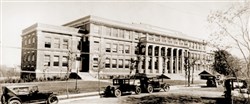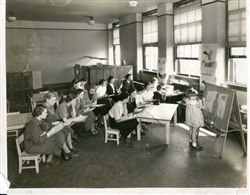 Home > Article
Home > Article
VOL. 38 | NO. 41 | Friday, October 10, 2014
University School of Nashville kicks off its centennial commemoration
By Sheila Burke

The old Peabody Demonstration School, which later became known as the University School of Nashville. This photo was taken just after the 1925 dedication of the new school building on Edgehill Avenue, USN’s current location. The school was located on Vanderbilt University’s Peabody campus from 1915 to 1925.
-- SubmittedIt was the summer of 1915, and a young Nashville educator had the audacity to suggest that a basement schoolroom on the grounds of the George Peabody College for Teachers might serve as a model for preparatory schools.
That vision by Dr. Thomas Alexander gave birth to what would become one of the city’s most prestigious schools: The University School of Nashville.
USN is marking its centennial with a series of celebrations to commemorate Alexander’s groundwork and the history of the school from the beginning as the Peabody Demonstration School.

Teachers in training takes notes during a class at Peabody Demonstration School, now USN.
-- Submitted“It’s a wonderful story not widely known,” USN director Vince Durnan says of the beginning. “The people who created the Peabody Demonstration School were visionaries in their time and worthy of study. So we’re paying attention to our own history in a way that has probably never happened on this campus in prior generations.”
Part of the centennial project involved $8 million in renovations to the facility. This included updating 42,000 square feet of an iconic design, adding 7,720 more feet and a new entrance and lobby.
A series of events, including screnings of film by USN alumni and the launching of two commemorative books, are part of the celebration. There will be an all-class reunion the first weekend in May.
The Peabody Demonstration School began as a model for Peabody College students to learn the cutting-edge teaching methods of the day. The idea was to help would-be teachers study best practices and test them in a real classroom.
It wasn’t long before it got the attention of important people outside of Nashville.
The school moved to its current location on Edgehill Avenue in 1925 with the help of a $750,000 grant from the Rockefeller Foundation. When the new building was dedicated, Alexander declared that it would be a “school to surpass all others.”
“To say that in Nashville, Tennessee in the 1920s is stunningly bold, and that’s our origin story,” Durnan says. “So I think it challenges us to be bold and to aim high and to expect more. The highest calling for us is to do something that would make our predecessor proud.”
The school ran into trouble in the 1970s and was almost forced to close. In 1974, Peabody College announced it would close the demonstration school because of financial difficulties. The announcement fueled a group of parents, teachers and friends of the school to rally to save it.
USN was among the first schools in Nashville to desegregate and had been welcoming to people of different religious, ethnic and racial backgrounds.
“In the ’70s, what was at the heart of the urgency of keeping the doors open was keeping an option available for families who celebrated difference in the school,” Durnan explains.
Parents and supporters bought the school gave it its new name.
Today, the school has a student population of 1,050 in grades K-12.
Notable alumni include:
- Pulitzer Prize-winning author and historian Robert K. Massie, whose books include “Nicholas and Alexandra and Catherine the Great” and “Portrait of a Woman”
- Jad Abumrad, founder and cohost of Radiolab on NPR
- Gideon Yu, co-owner of the San Francisco 49ers and former CEO of Youtube and Facebook
- Stanford Moore, a chemist and winner of the Nobel prize in chemistry
- Jenny Boucek, a WNBA coach and former player.
USN no longer serves as a demonstration and training school for teachers. But the school has remained relevant over the generations, Durnan says, noting the school has been pragmatic and focused on what should be taught as opposed to staking itself on any particular teaching orthodoxy.
Another reason the school has thrived is because of its commitment to getting different voices in the conversation, he adds.
“This place has been welcoming to people of different backgrounds for a very long time,” he said. “And as Nashville has changed and grown and included more and more diversity in its population, the school has benefited.”